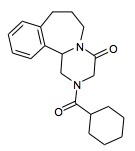Epsiprantel is a narrow-spectrum antiparasitic active ingredient used in veterinary medicine in dogs and cats against internal parasites, mainly tapeworms. It is not used against agricultural and household pests. It belongs to the chemical class of the isoquinolines.
Common name: EPSIPRANTEL
Type: veterinary medecine
Chemical class: isoquinoline
CHEMICAL STRUCTURE

EFFICACY AGAINST PARASITES
Type of action: Anthelmintic taenicide, endoparasiticide.
Main veterinary parasites controlled: tapeworms (=cestodes)
Efficacy against a specific parasite depends on the delivery form and on the dose administered. National regulatory authorities determine whether a product is approved for a given indication, i.e. use on a particular host at a specific dose and against a specific parasite. Check the labels of the products available in your country.
Click here for general information on features and characteristics of PARASITICIDES.
DOSING
Epsiprantel is a narrow-spectrum anthelmintic effective basically against tapeworms (e.g. Dipylidium caninum, Taenia spp). It is ineffective against any kind of roundworms, flukes or external parasites. It is used only in dogs and cats, sometimes combined with an appropriate nematicide (e.g. pyrantel). It is not used in livestock or horses.
Epsiprantel has almost no residual effect, i.e. it kills the parasites during a few hours after treatment but offers no significant protection against re-infestation.
The table below indicates some usual dosing recommendations for epsiprantel issued by manufacturers or documented in the scientific literature. They may not be approved in some countries.
| Dosing recommendations for EPSIPRANTEL |
||
| Delivery | Parasites |
Dose (against epsiprantel-susceptible parasites) |
| DOGS | ||
| Oral (tablets) | Tapeworms | 5.5 mg/kg |
| CATS | ||
| Oral | Tapeworms |
2.5-5.5 mg/kg |
DISCLAIMER: Liability is denied for any possible damage or harm to persons, animals or any other goods that could follow the transmission or use of the information, data or recommendations in this site by any site visitor or third parties.
Dosing recommendations for antiparasitics depend on national regulations. National regulatory authorities determine whether a product is approved for a given indication, i.e. use on a particular host at a specific dose and against a specific parasite. Check the labels of the products available in your country for specific information on approved indications.
SAFETY
Oral LD50, rat, acute*: >5000 mg/kg
Dermal LD50, rat, acute*: not found
* These values refer to the active ingredient. Toxicity has to be determined for each formulation as well. Formulations are usually significantly less toxic than the active ingredients.
MRL (maximum residue limit): not applicale: not approved for use in livestock
Withholding periods for meat, milk, eggs: not applicale: not approved for use in livestock
General safety information for antiparasitics is available in specific articles in this site (click to visit):
- General safety of antiparasitics for domestic animals
- General safety of antiparasitics for humans
- General safety of antiparasitics for the environment
|
It is obvious that veterinary products are not intended for and should never be used on humans!!! |
MARKETING & USAGE
Decade of introduction: 1980
Introduced by: PFIZER
Some original brands: CESTEX, BANMINTH
Patent: Expired (particular formulations may be still patent-protected)
Use in LIVESTOCK: No
Use in HORSES: No
Use in DOGS and CATS: Yes, very scarce
Main delivery forms:
Use in human medicine: No
Use in public/domestic hygiene: No
Use in agriculture: No
Generics available: Yes, very few
PARASITE RESISTANCE
In pets: No
In livestock: No
SPECIFIC FEATURES
Epsiprantel is an excellent taenicide belonging to the chemical class of the isoquinolines. However it is very scarcely used in dogs and cats (mainly as tablets) and not at all in livestock.
Due to its narrow spectrum of efficacy it is mostly used in combination with a broad-spectrum nematicide (e.g. macrocyclic lactones, benzimidazoles, tetrahydropyrimidines, etc.)
Efficacy of epsiprantel
Epsiprantel is highly effective against adults of many parasitic tapeworms (i.e. cestodes, e.g. of the genus Dipylidium, Taenia, Echinococcus, Mesocestoides, Moniezia, Avitellina, Stilesia, etc.). It is also effective against larvae and/or eggs of certain species.
It has no efficacy whatsoever against roundworms (nematodes) and flukes (trematodes), nor against external parasites.
Epsiprantel has no residual effect. This means that a single administration will kill the parasites present in the host at the time of treatment, but will not protect the host against re-infestations.
Pharmacokinetics of epsiprantel
After oral administration there is only very limited absorption of epsiprantel to the bloodstream. It seems that it is also poorly metabolized, since metabolites are not detectable in dog's urine. As a consequence epsiprantel remains longer in the gut than other compounds (e.g. praziquantel, another important taenicide), which favors its efficacy against tapeworms in the gut.
Mechanism of action of epsiprantel
The molecular mode of action of epsiprantel is not known. It is assumed that it is similar to the one of praziquantel, which seems to affect carbohydrate metabolism and to damage the worm's tegument structures. As a consequence the parasites cannot avoid being digested by the gastric fluids of the host.
Click here to view the list of all technical summaries of antiparasitic active ingredients in this site.